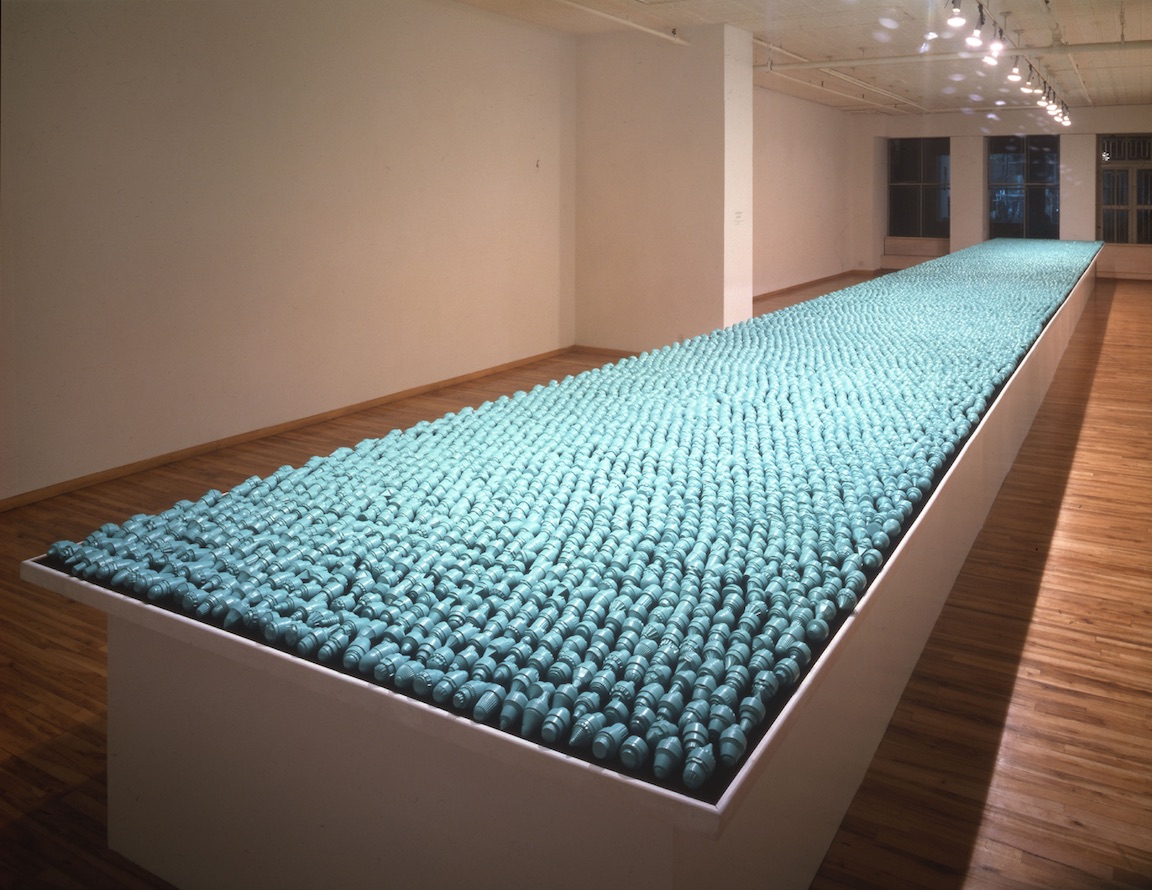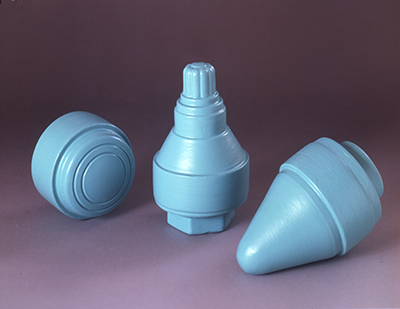Originally published in |
Download PDF version HERE: |
Originally published in |
Download PDF version HERE: |
|
|
 Allan McCollum, Over Ten Thousand Individual Works, enamel on cast Hydrocal, each 2" diameter by ca. 5". Installation: John Weber Gallery, New York.
|
ALLAN McCOLLUM JOHN WEBER GALLERY JOHN MILLER Individual Works, 1988, Allan McCollum's recent installation of rhetorical objects at John Weber Gallery, (running concurrently with the artist's exhibition of other works at a Annina Nosei Gallery and Julian Pretto Gallery), consisted of more than 10,000 plaster/Hydrocal castings displayed on a broad, velvet-lined pedestal, like a gigantic banquet table, that spanned the length of the gallery. This large structure aggressively theatricalized its surrounding as would a quintessentially minimalist sculpture a la Michael Fried, but the real drama here lay in the suspected individuality of the castings themselves: each painted with an aquamarine enamel for a plasticlike finish, each looking more or less like the next, but each purportedly unique. The objects seemed horribly familiar in a prosaic, utilitarian way, yet not quite definable: one would fit nicely in your hand—but for what reason? Every one of these objects, in fact, was produced by combining elements from two or more household items—bottle caps, doorknobs, cat toys, for example—in a system of assembly, as McCollum configured it, that could generate an even larger number of objects without duplication. Like his Surrogates, Perpetual Photos, and Perfect Vehicles, Individual Works effectively casts the stability of the subject/viewer into doubt. This project in particular calls to mind, both literally and figuratively, Melanie Klein's concept of the "art object." Klein's term refers to the infant's complete identification with the mother's breast, prior to attaining a fully resolved sense of self. McCollum, however, raises his examination of the precarious contingency of selfhood to a higher level of abstraction, that of global exchange: here, the production process supplants the breast. McCollum's viewer/consumer, like a helpless infant, seeks to purchase his or her selfhood by identifying with another unique "commodity." But the differences here among objects are so slight as to frustrate this project immediately. The effect of being overwhelmed by so many virtually indistinguishable choices parallels the regression of the individual and consumer society. Of course, production always implies distribution. McCollum addressed that arena of the market as well, jerry-rigging a strategy. He'd envisioned one-of-a-kind objects that would be affordable to anyone—cutting across at least one hallowed class barrier. For this exhibition, he stipulated that the works be sold either in ensemble or in standard lots of 575 parentheses (4 gross), to turn the retail operations of the gallery into wholesale operation with the hope that through secondary sales the works would reach that intended wider audience. McCollum's utopianism, however, ends up reflecting the insidious dysfunctions of mass culture market operations, in which the economics of universal availability and invidious prestige make conflicting demands. What's to prevent one collector or institution from buying up the entire set, turning the project into simply a monumental sculpture for hipsters? So just how and when the individual works of Individual Works will be distributed remains a question. Rather than inscribing a particular method of distribution in the work itself, McCollum leaves the final decisions to others, and what is intended as a radical gesture becomes, paradoxically, business as usual. Possession, as lawyers are wont to say, is nine-tenths tenths of the law. And when does the preoccupation with ownership become nine-tenths of the artwork? If its meaning is to be derived less from the domain of the artist's intension and more from that of the artist's actual (and more murky) practice, any comprehensive evaluation of Individual Works has to include a discussion of marketing procedures. In this, McCollum's work is salutary, for few artists have been willing to acknowledge the ironies of this issue in their own work, let alone grapple with them.  Detail |
Return to:
"Selected Texts"
Return to:
MAIN